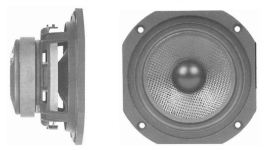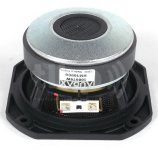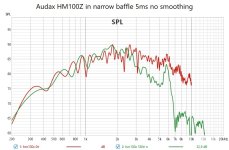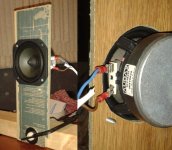Thanks Charlie,
I made an assumption that the rearward response might tell us something about the intrinsic nature if the cone. And although the rear response of the SB17MFC more closely follows the front respons3 for your naked/dipole application.
Between 3K and 8K it certainly isn’t as smooth as other drivers with poly cones… which was my region of interest..
I made an assumption that the rearward response might tell us something about the intrinsic nature if the cone. And although the rear response of the SB17MFC more closely follows the front respons3 for your naked/dipole application.
Between 3K and 8K it certainly isn’t as smooth as other drivers with poly cones… which was my region of interest..
I'm wondering what actually makes the difference so big in Charlie's 180deg measurements. Tried to look at pics showing surround and spider, but poor success. Obviously frame and motor of SBs are same?
Cone material and shape are different and maybe the backside of the cone laminate. Frontal responses show most difference int hose freq too, resonances.
SB15CRC
 SB15MFC
SB15MFC

Audax HM130C0


My measurements of Audax HM100Z0 (Aerogel)


Cone material and shape are different and maybe the backside of the cone laminate. Frontal responses show most difference int hose freq too, resonances.
SB15CRC
Audax HM130C0


My measurements of Audax HM100Z0 (Aerogel)


That driver does have a smooth looking on-axis frequency response curve. The frequency response as published in the datasheet of the SB17MFC35-8 is reproduced below. Its output rises to a broad resonance peak centered on about 6kHz. It seems that the breakup modes are much better controlled/damped than in those other drivers whose responses were shown a bit earlier.Next up for me – the SB17MFC. Allegedly the smoothest FR of all the SB15/SB17, ...
The datasheet results for the SB17MFC35-4 are quite similar to those shown above. However, the results presented elsewhere for the SB17MFC35-4 aren't quite as flattering (HiFiCompass Measurements SB17MFC35-4). It could be that the SB15MFC30-4 might be the smoothest of this bunch.
Last edited:
@CharlieLaub and All,
In the order of things, for speakers, my preference is Frequency Response first, then comes distortion most important to my ears is Amplitude modulation. Driver Harmonic Distortion is usually masked by the program material. I would like to see more distortion measurements in this thread.
FR and passive crossovers are covered well, thanks to @hifijim.
Bass reflex ports and Passive Radiators are not my favorite because of the delayed port or radiator output and all the other noise and mid-range that leaks out.
I have drilled multiple smallish resistive holes in an otherwise sealed enclosure to relieve high internal pressure to reduce air pressure compliance. Think of a Microphone in the box measuring internal impulse response. Delayed echoes leak out of the port or PR for way too long. Resistive venting changes a lot of things. I believe improving the sound quality. Also high pass filter the woofer and add a sub, also helps the sound quality by reducing the woofer excursion.
Thanks DT
In the order of things, for speakers, my preference is Frequency Response first, then comes distortion most important to my ears is Amplitude modulation. Driver Harmonic Distortion is usually masked by the program material. I would like to see more distortion measurements in this thread.
FR and passive crossovers are covered well, thanks to @hifijim.
Bass reflex ports and Passive Radiators are not my favorite because of the delayed port or radiator output and all the other noise and mid-range that leaks out.
I have drilled multiple smallish resistive holes in an otherwise sealed enclosure to relieve high internal pressure to reduce air pressure compliance. Think of a Microphone in the box measuring internal impulse response. Delayed echoes leak out of the port or PR for way too long. Resistive venting changes a lot of things. I believe improving the sound quality. Also high pass filter the woofer and add a sub, also helps the sound quality by reducing the woofer excursion.
Thanks DT
A vented box will have higher pressures than a sealed box.
A vented box will have higher pressures than a sealed box.
Please show us how that works.
I have a GRAS 46BF-1 pressure sensor calibrated in dB/pascal.
Thanks DT
https://www.grasacoustics.com/?eID=1709645390&import_id=686
The following papers may shed some light on this topic:A vented box will have higher pressures than a sealed box.
Small, R. H. (1971). Simplified Loudspeaker Measurements at Low Frequencies. Proceedings of the I.R.E.E. Australia, August, pages 299–305.
Small, R. H. (1972). Simplified Loudspeaker Measurements at Low Frequencies. Journal of the Audio Engineering Society, Volume 20, Number 1, January/February, pages 28–33.
Chasing the thought the @witwald brought up, I did some more simulation experiment with active filter options. This is all theoretical, I have no interest in building or testing an active filter version of this speaker… but it is interesting to see what would be possible.
@witwald noticed the shallow LR2 slopes on the mid-tweeter crossover. My other active designs often use LR4 on the mid-tweeter section, so I experimented with 4th order slopes here.
The overall directivity performance is nearly the same between LR2 and LR4. I consider the PIR curve to be rather important, because it blends together the power curve, the ER curve, and the listening window curve according to the frequency range in which each curve influences the perception. Here we can see that the PIR curve is virtually the same between the two. [In the Power&DI plots below, the heavy black line is the PIR curve]
However, there is a difference in vertical polar response. To me this means that the two filter options will have a different character that is room dependent. Some rooms may prefer the LR4, and some may prefer the LR2… Yet another reason to like DSP active filters…



======== ============= ==============
In other news, I have started applying veneer to the cabinets. ... j.

@witwald noticed the shallow LR2 slopes on the mid-tweeter crossover. My other active designs often use LR4 on the mid-tweeter section, so I experimented with 4th order slopes here.
The overall directivity performance is nearly the same between LR2 and LR4. I consider the PIR curve to be rather important, because it blends together the power curve, the ER curve, and the listening window curve according to the frequency range in which each curve influences the perception. Here we can see that the PIR curve is virtually the same between the two. [In the Power&DI plots below, the heavy black line is the PIR curve]
However, there is a difference in vertical polar response. To me this means that the two filter options will have a different character that is room dependent. Some rooms may prefer the LR4, and some may prefer the LR2… Yet another reason to like DSP active filters…
======== ============= ==============
In other news, I have started applying veneer to the cabinets. ... j.
Hello All,
Crossover terminology is interesting; 2-pole at 12dB/octave slope, 3-pole at 18dB/octave slope and 4-pole at 24dB/octave slope.
Close one eye and take a closer look at the crossover slopes at the crossover points. The slopes are a fair amount less than nominal value expected.
Crossover terminology is interesting; 2-pole at 12dB/octave slope, 3-pole at 18dB/octave slope and 4-pole at 24dB/octave slope.
Close one eye and take a closer look at the crossover slopes at the crossover points. The slopes are a fair amount less than nominal value expected.
Hello,The following papers may shed some light on this topic:
Small, R. H. (1971). Simplified Loudspeaker Measurements at Low Frequencies. Proceedings of the I.R.E.E. Australia, August, pages 299–305.
Small, R. H. (1972). Simplified Loudspeaker Measurements at Low Frequencies. Journal of the Audio Engineering Society, Volume 20, Number 1, January/February, pages 28–33.
I have read the Small paper before, it is printed tabbed and highlighted on my table. Also on my bench is a copy of the MIT 1954 text which is Reference [2] in the Small paper, that you pointed out above. Most of the number crunching formulas in the paper come from the 1954 L. Beranek "Acoustics" textbook.
Nothing in the Small paper or the Referenced Acoustics text indicates that a ported or vented enclosure will measure higher internal pressures because of a port , PR or another type of compliance reduction.
I have measured internal enclosure pressures of more than a few speakers both sealed and vented. Greater Enclosure Losses result in reduced compliance and reduced enclosure internal pressure.
Drill a small hole and measure some pressures. If you do not have a Lab Grade Microphone turn a tweeter around facing the interior of a enclosure and measure pressure that way.
Thanks DT
I have drilled multiple smallish resistive holes in an otherwise sealed enclosure to relieve high internal pressure to reduce air pressure compliance. ...
What do you consider "smallish", 1/8", 1/4"?
About how many holes do you use?
Linkwitz recommended a small hole in his subwoofer
"The box is completely sealed except for a small pin hole (<1 mm diameter) to equalize internal with external static pressure and to prevent displacing the cone from its normal resting position."
https://www.linkwitzlab.com/thor-design.htm
Maths and nice drawings from the same page regarding pressure

"The box is completely sealed except for a small pin hole (<1 mm diameter) to equalize internal with external static pressure and to prevent displacing the cone from its normal resting position."
https://www.linkwitzlab.com/thor-design.htm
Maths and nice drawings from the same page regarding pressure
Note that Linkwitz added the hole to the subwoofer enclosure in order to "equalize internal with external static pressure". That's not the same as adding a bunch of holes for the purpose of creating resistive losses. A single pressure-equalization hole of very small diameter will not introduce much in the way of extra resistive losses, as the flow inwards and outwards per cycle will be very small.
I have not measured nor calculated pressures. But pressure tranlates to spl (Sound Pressure Level), right?
Linkwitz shows formula how to calculate, but available amp power and driver motor parameters are the limiting factors. As consequence external spl gets suppressed, it doesn't linearly follow the math model - and respectively does the internal. A reflex box makes the driver's work easier until below tuning F the internal compression strikes back very fast again.
DT, please show us some spl/F curves!
Linkwitz shows formula how to calculate, but available amp power and driver motor parameters are the limiting factors. As consequence external spl gets suppressed, it doesn't linearly follow the math model - and respectively does the internal. A reflex box makes the driver's work easier until below tuning F the internal compression strikes back very fast again.
DT, please show us some spl/F curves!
Not this whole discussion again.Linkwitz recommended a small hole in his subwoofer
Linkwitz only proposed a hypothesis, the significance of it was never tested.
If you understand how pressure differences work, and how they are created, you will quickly realize that it's a extremely far fetched idea.
I have explained this extensively in another thread so I am not going to repeat the entire thing once again.
Linkwitz always had some good, inspiring and interesting reads, but the majority of his ideas are all hypothesis.
With sometimes only little proof to back it up.
I am skeptical that a small hole in a sealed box has any benefit. No wood/mdf/plywood box is going to be air tight, to the point where it could maintain a few millibar pressure differential over a long term (i.e. hours or days)... and this is the level of "air tightness" that would be required before we would have to worry about equalizing atmospheric pressure. Basic ideal gas law shows that even in an air tight box, it is not an issue with normal barometric variations at normal temperatures.
But a 1/16" or 3/32" hole (1.5 mm or 2 mm) is not going to do any harm, so if a person wants to do it, go right ahead and do it.
But a 1/16" or 3/32" hole (1.5 mm or 2 mm) is not going to do any harm, so if a person wants to do it, go right ahead and do it.
It doesn't, unless:I am skeptical that a small hole in a sealed box has any benefit. No wood/mdf/plywood box is going to be air tight, to the point where it could maintain a few millibar pressure differential over a long term (i.e. hours or days)...
For static pressure
1 - we assume that the cabinet + loudspeaker are 100% air tight
(which they are not, very far from it -> see Q factor of system)
2 - you assemble the whole system in an environment that is wildly different than the room in sense of temperature and static pressure.
Which is basically this.Basic ideal gas law shows that even in an air tight box, it is not an issue with normal barometric variations at normal temperatures.
And even if so, which is a bit ridiculous if you do the math, see point 1 again.
I am not fan of holes, unless you maybe cover it up with some foam or so.
But they can create quite some turbulence noises at full excursion, and not just a little bit.
Although that heavily depends on how it's done, but it wouldn't be my generic advise for exactly that reason.
Last edited:
Well, we are saying the same thing, but I prefer to state my opinion in a way which is not so categorically definitive. After all, it is possible that someone, somewhere, constructed a cabinet which was truly airtight, and then installed a woofer which was truly airtight, and then used the speaker in an environment (temperature/pressure) where the differential pressure pushed the voice coil away from static position enough to influence the performance. So I will not go so far as to say that "A small hole has no benefit", because in some extremely rare instance, a small hole might have a benefit.
Instead I will say that I am skeptical that a hole has any benefit... meaning that in the vast majority of conventional sealed box designs, using conventional construction techniques and operated in a normal fashion, a small hole does nothing. But I am also acknowledging that there could be rare exceptions. I am also acknowledging that there could be future analysis or empirical findings which refute my assertion. This is what I mean when I say "I am skeptical there is a benefit"...
I hate to dig in deeply on the semantics of this, but I have noticed a growing trend over the last 20 years or so with scientist and engineers (but more so with scientists). This trend is to express their hypothesis and opinions to the general public as if they are established facts. "This is the position of the continental plates during the Triassic period"... "Here is the extent of glaciation 100,000 years ago"... "You must avoid all foods with cholesterol and limit your sodium intake" ... "The earth will achieve peak oil production in 1993"... "black holes are formed by the collapse of a star, so the concept of a super massive black hole is preposterous"... We can find hundreds of examples of scientific opinions being expressed as fact, which were revised later as more data and evidence came to light. All of those hundreds of original statements should have been properly caveated with "According to our latest evidence and analysis, we believe XYZ PDQ, but we could be wrong". Instead, these scientists frequently express their latest opinions with same level of certainty they would express basic scientific laws, such as conservation of mass, or conservation of energy, or Faraday's law. So, I have become rather sensitive to this. @b_force - I am not singling you out for criticism, this is something I have been wanting to say for a long time. Your post above was just a convenient opening for me to climb on my high horse and deliver a lecture no one wants to hear... 🙂
j.
Instead I will say that I am skeptical that a hole has any benefit... meaning that in the vast majority of conventional sealed box designs, using conventional construction techniques and operated in a normal fashion, a small hole does nothing. But I am also acknowledging that there could be rare exceptions. I am also acknowledging that there could be future analysis or empirical findings which refute my assertion. This is what I mean when I say "I am skeptical there is a benefit"...
I hate to dig in deeply on the semantics of this, but I have noticed a growing trend over the last 20 years or so with scientist and engineers (but more so with scientists). This trend is to express their hypothesis and opinions to the general public as if they are established facts. "This is the position of the continental plates during the Triassic period"... "Here is the extent of glaciation 100,000 years ago"... "You must avoid all foods with cholesterol and limit your sodium intake" ... "The earth will achieve peak oil production in 1993"... "black holes are formed by the collapse of a star, so the concept of a super massive black hole is preposterous"... We can find hundreds of examples of scientific opinions being expressed as fact, which were revised later as more data and evidence came to light. All of those hundreds of original statements should have been properly caveated with "According to our latest evidence and analysis, we believe XYZ PDQ, but we could be wrong". Instead, these scientists frequently express their latest opinions with same level of certainty they would express basic scientific laws, such as conservation of mass, or conservation of energy, or Faraday's law. So, I have become rather sensitive to this. @b_force - I am not singling you out for criticism, this is something I have been wanting to say for a long time. Your post above was just a convenient opening for me to climb on my high horse and deliver a lecture no one wants to hear... 🙂
j.
Can only agree.I am skeptical that a small hole in a sealed box has any benefit. No wood/mdf/plywood box is going to be air tight, to the point where it could maintain a few millibar pressure differential over a long term (i.e. hours or days)... and this is the level of "air tightness" that would be required before we would have to worry about equalizing atmospheric pressure. Basic ideal gas law shows that even in an air tight box, it is not an issue with normal barometric variations at normal temperatures.
But a 1/16" or 3/32" hole (1.5 mm or 2 mm) is not going to do any harm, so if a person wants to do it, go right ahead and do it.
It doesn't, unless:
For static pressure
1 - we assume that the cabinet + loudspeaker are 100% air tight
(which they are not, very far from it -> see Q factor of system)
2 - you assemble the whole system in an environment that is wildly different than the room in sense of temperature and static pressure.
Which is basically this.
And even if so, which is a bit ridiculous if you do the math, see point 1 again.
I am not fan of holes, unless you maybe cover it up with some foam or so.
But they can create quite some turbulence noises at full excursion, and not just a little bit.
Although that heavily depends on how it's done, but it wouldn't be my generic advise for exactly that reason.
Basic Acoustics
Basic Thermodynamics
Adiabatic Compression
These topics are covered in the AES Library of papers by the grandfathers like Richard Small.
Linkwitz did not make this stuff up.
Many or most of the documents reference the MIT 1954 text "Acoustics" by L L Beranek. You can down load it on line. The old hardback books are expensive and hard to find.
Also, if you must, take a look at https://www.cieri.net/Documenti/JBL/Technical Notes/detailpage/detail038.html for a discussion of compression distortion.
If you want to know about small holes, large holes, turbulent flow, laminar flow, resistive ports, tuned ports or whatever the enclosure losses or tuning, read the text.
The science has not changed, the ability of the computers and software has.
A bit of trivia:
I often drill a single 9/32 inch hole (1/4" + a little bit) to place a 1/4" microphone "in the box" for measurements. More than once I have neglected to plug the hole. It makes no measurable difference to the direct field measurements if the single small hole is covered or not.
Thanks DT
Last edited:
- Home
- Loudspeakers
- Multi-Way
- Some Interesting Drivers, a New 3-way Project